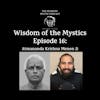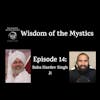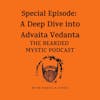Thoughts on the Bhagavad Gita (Chapter 13: Verses 30 - 35)
In this episode, the host, Rahul N Singh, delves into the Bhagavad Gita, focusing on Chapter 13, verses 30 to 35. He talks about Hindu philosophical concepts like Karma, Prakriti, and Atma, elaborates on the idea of Akarta (non-doer within actions), and explores the concept of cause and effect. He further discusses the wisdom shared by Sri Krishna, the discernment between the physical body and the Atma that exists within, and the significance of the third eye in achieving enlightened discernment. The episode ends with reflections on achieving liberation and the state of Jivan Mukti, which signifies freedom from the cycle of life and death while being alive.
Translation used: The Bhagavad Gita Comes Alive: A Radical Translation by Jeffrey Armstrong
If you enjoyed listening to the 90th episode of the Thoughts on The Bhagavad Gita and want to listen to more episodes like this on the Bhagavad Gita, or on Non-Duality, or the wisdom of the Mystics please follow/subscribe to this Podcast. New episodes are uploaded every Sunday.
Thoughts on the Upanishads, Conversations with the Bearded Mystic, Guided Meditations, and much more only on Patreon, Buzzsprout Subscriptions, Apple Podcast Subscriptions and Supercast.
Patreon: Support The Bearded Mystic Podcast and get ad-free, bonus episodes along with many more benefits:
https://www.patreon.com/thebeardedmysticpodcast
Join The Bearded Mystic Podcast Discussion Group on Whatsapp: https://chat.whatsapp.com/GcCnyrjQwLuEPHBaVA6q9L
Be notified of my weekly virtual meditation session followed by a Q&A Discussion via zoom (Notifications only):
https://chat.whatsapp.com/DcdnuDMeRnW53E0seVp28b
Please rate and write a review for this Podcast: https://www.thebeardedmysticpodcast.com/reviews/new/
You can follow me and contact me on social media:
Website: https://www.thebeardedmysticpodcast.com
TikTok: https://vm.tiktok.com/ZMdk3HPJh/
Instagram: https://www.instagram.com/thebeardedmysticpodcast/
Youtube: https://www.youtube.com/c/TheBeardedMysticPodcast/
Twitter: https://twitter.com/bearded_mystic
Facebook: https://www.facebook.com/The-Bearded-Mystic-Podcast
Rahul N Singh:
Hello and welcome to the Bearded Mystic Podcast and I'm your host, Rahul N Singh. Thank you for taking out the time today to either watch or listen to this podcast episode. If you are really interested in supporting The Bearded Mystic Podcast, and you've found great benefit in listening or watching these episodes, then please do support this podcast on Patreon where you can get ad free and bonus episodes along with other benefits depending on the tier that you select. Your support means everything, and it really does help the podcast keep running efficiently and smoothly, and also widens the audience that this message can reach to. If you would like to know more about it, the details are in the show notes and video description below. On Saturdays at 11:00 AM Eastern Standard Time there is a free virtual meditation session along with discussion and Q&A. If you're interested in meditating with us as a community, then you can find out the details in the show notes and video description below. Please do like, comment, and subscribe if you're watching this on YouTube and if you're listening to this on your favorite podcast streaming app, then please do give this podcast a five star rating. It helps the podcast get up in the charts and allows the algorithm to bring this podcast to new listeners and also do review the podcast if you can and make sure you do follow or subscribe to keep getting future episodes. Today we will be continuing on with my thoughts on the Bhagavad Gita, and today we will be looking at chapter 13, verses 30 to verse 35. This will conclude chapter 13 for us today. Let's begin with verse 30. One who finally realizes that the cause and effect happening within Prakriti is being carried out entirely by reciprocal actions and reactions within matter, finally sees that the Atma has no permanent connection with matter, and realizes themselves to be Akarta meaning, not the material doer within prakriti. An amazing verse, and we're going to look at the verse as completely as a whole here. So, this is something we've mentioned in the previous episode very briefly and now we're going to make sure that we fully understand this because Sri Krishna is elaborating on what it means to be the akarta, to be the non doer within actions. So first of all, cause and effect is essentially karma here. That's what Sri Krishna is referring to as karma. So you do an action, that's the cause and whatever occurs from that action is the effect. So we cannot escape this. As long as we live in the world, as long as we are in a body, we will always have an effect. For example, even if you eat food, the effect is, it's going to be digested in your body. And the result of that depends on if you've had good food or bad food. Same thing with anything else. You breathe in, the effect is that you're breathing in, hopefully, good air. Yeah, so it's vital for you. So, everything we do is based on karma. Even those that say they are meditating, the cause is meditation, the effect of meditation is liberation. So there's a cause and effect for everything, right? Essentially a true seeker will understand this. Then we need to understand that all karma happens within Prakriti and it is Prakriti that gives us those reciprocal actions and reactions. For example, whatever we do is happening within Prakriti. If I'm doing anything today, it's happening in this earth. The earth is my playing field right now, right? I don't need to pretend that this is not happening in Prakriti, you know, every action is happening within Prakriti and therefore in this field of the world, in this Prakriti, that's going to give me the reactions of my actions. Yeah, that's going to define what those reactions are going to be. I don't have to pretend that it is something else. I don't need to say, Oh, God did this to me. No, nature is giving back what I gave to nature. If I am being harmful towards nature, nature will be harmful back. It doesn't work in that way. That's why, remember, in previous episodes, we've discussed how we have to look after the elements, the devas, yeah? Because when we look after those basic elements of life, then that's reciprocated. Today, do we value water the same way? Do we value the earth in the same way? Do we value fire in the same way? Do we value air in the same way? I don't think we do. So if we are not valuing those things, then we will get the reciprocal reactions back. And they all happen within matter, remember? Don't think that it's happening somewhere else. You know, in heaven there'd be a reaction or in hell. No. All the reactions are done on this earth and the Purusha or the ultimate reality does not react, nor does it respond within matter. Remember he says that one who finally realizes that the cause and effect happening within prakriti is being carried out entirely by reciprocal actions and reactions within matter. So that person understands everything that I do in this body and mind is going to be finding its reciprocal action and reaction in this earth. They finally see that the Atma has no permanent connection with matter. This being will understand that the Purusha within me has no reaction or nor does it respond within matter. It has no permanent connection. Connection is very temporary because it's based on the body and mind. But the Purusha is separate to the body and mind, or you could say immersed in the body and mind yet separate. It's within yet distinct. So the person who understands that karma only affects the body and mind and not the formless awareness within, they understand that this seemingly permanent connection with the world ceases, they understand that there's no longer this permanent connection and what they have is, is a temporary yet fulfilling relationship as formless awareness to Prakriti. So they absolutely respect Prakriti, they absolutely adore Prakriti, they are sensitive, compassionate towards Prakriti, they will not condemn the world, they will not condemn nature. They will understand what's going on and they will have a loving relationship with nature, yeah, but they know that it's not a permanent connection, it's very temporary. Ultimately, because they are formless awareness and that is their permanent state, they find that they are not the material doers within prakriti. For example, they will understand that this witness consciousness within does not get touched by the actions and reactions of the world. It remains stable. It's the mind that projects pleasure. It's the mind that projects pain. But the Purusha, the witness consciousness, the formless awareness within, does not experience pleasure or pain. It just highlights. It just puts a light on it. That's all. That's why it's the Akarta. And the person who understands how Prakriti works, understands they're the Purusha and therefore they understand they are the akarta They are not the material doer within prakriti because they don't associate with the body and mind, they associate themselves with Consciousness. They go beyond any sense of doership and this is essentially the result of understanding the truth. When we are able to really consolidate this feeling within our own mind and within our own awareness, then we move forward, then we go further on in our journey. Verse 31. When the individual Atman perceives that all states of being within prakriti are actually resting upon the platform of Brahman. Then they are again restored to their original Brahman nature. We're going to break this verse up. When the individual Atma perceives that all states of being within Prakriti are actually resting upon the platform of Brahman. So what does this mean? The individual mind will understand that all the senses, the vasanas, the reactions, the waking, dreaming and deep sleep. They are all within Prakriti. The Panchakoshas are within Prakriti. Yeah, this body, this mind, prana, the intellect, the, bliss that we get from deep sleep, all that's within prakriti. All of it is the body. And one sees that within prakriti, there's also the three gunas and the mind acts accordingly. But when one realizes Brahman, this is the important point, but when one realizes Brahman, they see that all of this is resting upon Brahman, all of this is emanating from Brahman, without Brahman the source, as a source of all, it cannot be. Yeah, so the original cause is Brahman, and this is seen in the Brahma Sutras, if you read it, it's there. Brahman is the underlying substratum in all of existence, and without that foundation of Brahman, none of this can be. Yes, simply that's what we can understand. And then Sri Krishna says, in that verse, then they are again restored to their original Brahman nature. So due to this understanding and perception, the Atma realises its It's true self. Then it understands I am formless awareness. I am not this body. I'm not this mind. It becomes Brahman itself. Once you know you're a Brahman, then you're Brahman. There's no way you can come out of that. You totally immerse yourself as formless awareness. You go, you break away completely from prakriti and you identify completely as formless awareness. Then, the three gunas cannot affect you, neither can the senses divert your attention, nor can the mind try to manipulate you, nor can your emotions divert you. Nor can your thoughts distract you. None of that will happen because you are restored to your original Brahman nature. And here is the important point. He says restored to their original Brahman nature. Meaning, you've always been this. You're just restored back. You were pretending to be something else. Now you will understand you are this. And that is what Sri Krishna is talking about. That's what Sri Krishna is engaging us with. So we can explore this knowledge. So we can explore this wisdom. Then verse 32. In addition, O Arjuna, even though Param-atma is abiding within each body, that supreme maintainer of all, is with no beginning, never affected by the gunas, imperishable, situated within each body, not acting within the grasp of cause and effect. and untouched by the results of karma and or action. This is brilliant. So let's break this verse up. There's so much to explore here. In addition, Oh Arjuna, even though Param-atma is abiding within each body. So the Supreme Brahman is within everybody. This formless awareness is within every single body that we know. Your loved ones, your hated ones, it's in everyone. Your friends and your foes. It is living in each body as itself. It's not living as some separate entity. This body thinks it's different, but this awareness knows it is the body. This body is an appearance in this awareness, that's what this pure awareness, this formless awareness knows. And we are to continuously abide with Brahman. So while we are trying to get rid of this duality, we need to live in the awareness that we are Brahman, that Aham Brahmasmi, Aham Brahmasmi. Not just saying it, but really feeling it, that you are Brahman, I am Brahman. And really understanding it, really practicing it. So there's a few qualities that Sri Krishna gives. It's with no beginning and it's never affected by any of the gunas. So this Brahman has no beginning at all, it is self existent, it is uncreated, it is never affected by the three gunas, neither sattva, rajas or tamas can touch it. The three gunas are not performed in Brahman, they do not exist within Brahman, nor do they manipulate in Brahman, nor do any attributes affect this Brahman, no attributes define it, and it is completely attributeless. It's nirgun. So it's never affected by any of the gunas and because it's with no beginning it cannot have an attribute either. Then it is imperishable and situated within each body. One, it is imperishable meaning it cannot be destroyed in any way, it cannot be modified in any way, it cannot be changed in any way and therefore being all of existence it is situated within each body. Everything is living in Oneness. This becomes our realisation, and it is the eternal formless awareness, and we realise it when we are aware of formless awareness. Then we understand how it's situated in the body, and not just in my body, but in every single body of existence, and existence itself. And then It says it is not acting within the grasp of cause and effect and it is untouched by the results of any karma or action. So it does not act according to cause and effect. It does not respond to cause and effect, neither is it manipulated or modified because of any cause and effect. It doesn't get entangled in any cause and effect at all. Cause and effect only occur within prakriti, but not in awareness. Nor is it touched by any of the results of karma or action, no pain touches it, no pleasure touches it, no happiness touches it, no sadness touches it, no loss touches it, no profit touches it, it transcends all results of karmas and actions. So we can see it completely free and what Sri Krishna really is defining here is that somebody that realises that I am Brahman and truly understands that there is only Brahman, there is only this formless awareness, I am this formless awareness, they achieve ultimate freedom, real freedom. Then verse 33. Just as Vayu, air, and Akash, space, appear to be mixed together, but do not really blend, so the Deha, the physical body, and Dehi, the Atma, also never blend, even though the Atma is seated within the body. This is a really interesting verse, one we're going to break up, so we can fully understand it. The first part is, just as Vayu Air, and Akash Space, appear to be mixed together, but do not really blend. It appears that air is in space, and they both exist within each other, and they both mix with each other, and where there is space, there is air, and where there is air, there is space, but that's not essentially true, and another quality that people see, which is why they think this way, is that it has no form. Yeah, we cannot see the form of air unless there's a, another cause behind it. So for example, if it's cold and then you have heat, then you can see, steam, but otherwise you can't. But actually, they are both separate in a very subtle way and air is not everywhere in existence. It's only on this earth. We experience it because we're on this earth, but on every planet, there may not be air. In deep dark space, there may not be air. So the one thing to note here is by using this analogy, Sri Krishna is making us think and trying to make us think how is this related to the Atma in the body. Because obviously he said that the Atma is seated within the body, Brahman is within the body. How can I understand that it's seated there? So the next part of the verse says, the Deha, the physical body, and Dehi, Atma, also never blend, even though the Atma is seated within the body. First of all, this Atma and the body, they never blend, they never mix together. Subtly, the Atma is beyond the physical body. Although it pervades the physical body, it's also beyond the physical body. And even though the Atma is within the body, it does not mix with the body. It does not mess with the functions. It's not responsible for what happens in the digestive system. It's not responsible for what happens in the heart, or the lungs, or the respiratory system. It does not interfere, nor does it do anything about it. This is always beyond that, so that's why Law of Attraction ever appeals to me about, you know, healing your own self, that idea that consciousness can heal you, consciousness has nothing to do with healing. Yeah, in that sense, so all it does, consciousness is always separate, so it does not mix with the body. The Atma is formless and the body appears as a form, even though the body is essentially formless because it's made of atoms and atoms are essentially empty space, but really the Atma we know is definitely formless And we know that the body appears as a form. Consciousness is formless, body appears to have a form. And the Atma is transcendent and is everywhere. Yet seated within every heart. So when I say every heart, every, in every being. One thing to understand is, and if we can truly understand this, then we're doing good. The way to see this verse is, I have a body and yet my awareness seems untouched by the body. Even though it's situated in the body, because it is awareness within this confinement that is aware of itself. Yeah, it's even aware of the confinement that it's in, and at the same time, it is aware of how transcendent it is, aware of how boundless it is. So this is something that we can experience and we can understand, essentially. So this is how the Atma and the body remains together. This knowledge that we get is essential to understand and it's only understood when we are one with the Guru, when we are one with this Param-atma, when we understand the Guru's teachings, then we can really transcend. But until we really believe this to be true, we will always believe with the body. So we have to have full faith that what the Guru is telling us, what Sri Krishna is telling us is absolutely true. And now that you've had this knowledge, Now that you know that the Atma never blends with the body, yet is seated within the body, Now you should have an insight. This is Brahm Gyan, the insight into Brahman, the insight into formless awareness. Then you realise how the formless awareness within resides. And now verse 34. Just as Ravi, the sun, lights up our entire planet, so the Atma illuminates the body it occupies. While Param-atma is Kshetra, kshetri, Kritsna, the one who pervades and illuminates the entire universe. Let's break this verse up. Just as Ravi, the sun, lights up our entire planet, so the Atma illuminates the body it occupies. For example, we know that when the sun radiates in the sky and it's morning. we can see outside and that light enters in the home and it lights all the objects in the home. When the sun radiates, we also see the moon at night and the stars and the sun helps us navigate the way. When we're in, when we're out somewhere, the sun helps us and most of the time, if you remember, when we're traveling, we like to travel in the day because we can see everything. When it's night time, it's very difficult. Likewise, when the Atma radiates, then we see the objects of the world, then we see the objects of Prakriti. So the Atma radiates, the formless awareness radiates, and we see the inner eternal witness and observer. Once we become aware of the awareness, then we awaken to understand what is the inner eternal Witness and Observer. And then the Atma, the Formless Awareness, takes us from body consciousness to becoming aware of awareness that is within the body that it occupies. So literally, that's what it does. It just shows that, listen, because I am here, this Atma is here, because I am Formless Awareness and because I exist here, you are able to function your body. Without my awareness, this body will not function. And this is true. When we say that the Atma has left the body, it's just a metaphor to say that that pure consciousness is no longer confined in the body and the body was not able to contain that energy. You know, that kind of, um, that very vibrant energy of the Atma, hence it has to travel from birth to birth as a jiva-atma. Once we are able to break away from the association of the body, identification of the body while we're alive, then the Atma is free. Then it's no longer confined, so this body will just function unto it's natural end within Prakriti. It's natural end. It will not be forced, it will be a natural end. And then Sri Krishna says, while Param-atma is Kshetri Kritsna, which is the one who pervades and illuminates the entire universe. So this ultimate being, this Param-atma, this Supreme Atma, the, the formless awareness that is Nirgun Brahman, is the one that pervades and illuminates the entire universe. Just as our formless awareness that's within our own body illuminates just our body, once we become awakened and understand that the Atma is Param-atma, then we understand that it's not just this body, this Param-atma is everywhere. This Atma that I thought was just here, It's actually now everywhere, here within my body, now it's in every living being, in all of existence and beyond existence, beyond prakriti. And within prakriti and because of this, it illuminates the entire universe, the entire universe gets its illumination from this formless awareness and it is this shared being that is within everyone, including space and on the ultimate level, as we've been discussing on this podcast, as we've been constantly talking about, that there is only the Param-atma, there's only Brahman, that's all. Then verse 35. Thus, the ability to distinguish between the field and the knower of the field within prakriti and between the two Purushas, which is the Atman and Param-Atman, causes the jnana chakshusha the third eye of enlightened discernment to open. The Yogi then becomes permanently liberated from Prakriti's control over their definition of Self. In that fully awakened state, they return to the transcendental realm of Brahman, never to experience material bondage again. This, my friends, is liberation. This is what we need to attain. Let's break this verse up, so we can fully understand this. Thus the ability to distinguish between the field, and the knower of the field within Prakriti, and between the two Purushas, the Atma and Param-atma, causes the Gyan Chakshu, the third eye of enlightened discernment, to open. So third eye, remember, is just a metaphor, it's basically the insights into Brahman, insights into formless awareness. It's very important to tell the difference between the body, which is the field, and also the awareness, which is the knower of the field. So it's very important to distinguish between prakriti and purusha at all times. This needs to be our continuous practice until we understand that we are formless awareness. Until then, we are not to rest. Yeah, if we still think we are prakriti in any way. We have to keep returning to this awareness and that gives us the gyan chakshu. That gives us the third eye or the insight of enlightened discernment. It's important to know the difference between the world and the self. It's important to know the difference between maya and brahman. And it's important to know the difference between name and form and formless awareness. It's very important to know those differences. Now, he also mentions there's the two purushas too. Now, is there really a difference between the two Purushas? Not in its true essence. The Atma and Param-atma are one and the same, yet what we consider here just for the sake of definitions, one is the Atma when one thinks one is the awareness only in the body and Param-atma is the awareness that exists in everywhere and in everything. So once we understand that we are that ultimate Purusha, then we're good. Then we know that in everything and everywhere, meaning that includes my own body. So this awareness is not restricted here, it's immersed everywhere. To help us transcend, we go from this body, to the Atma and then to Param-atma. We go through neti neti So we break down the body through neti neti and understand that we are not this, not that. Then we go to the Atma or the awareness of thought, awareness of breathing, awareness of body, awareness of mind. We are that awareness, that awareness is within this body Then we understand what happens when this body goes. Then what happens to the Atma? Oh, this Atma is just not here. It's everywhere in everything. Yeah, and it's everywhere. So it's beyond all the bodies of this world. Yet, if it's in my body, individually here, it's also within everybody. So it's that one Atma within everyone. It's very simple, but pretty complex to understand if you've, if this is your first episode that you're watching of this. I do recommend you start from the beginning, but this is essentially what it is. And if you've got it, like this video, share this, because it's important that we understand this. We view this only when we see life through the Gyan. Once we use the Gyan Chakshu in all aspects, when we are literally looking for the insights into Brahman, of enlightened discernment, then we are always going to live our life through the Gyan. When we witness and observe life through the vision of Brahman, when we discern with our intellect based in Gyan, we see only this one Brahman. And it is this Gyan that opens the third eye, or the divine vision, or the insights into Brahman. So this is a stage that we have to do. First of all, we have to understand what is prakriti. Once we understand what prakriti is, then we say, well, what is observing all of this prakriti within me? Oh, this is the Atman, the witness conscious within my body, but it's not associated with my body. It does not identify with my body. It's just contained in my body. One then discerns that, well, does this last even after I die? After this body disappears? When this body dissolves, where does my awareness go? Oh, it becomes boundless. That's how it becomes Param-atma. So this constant practice of this neti neti approach, this discernment, that's utilizing gyan chakshu. Then we start seeing everything as Param-atma. Then we start seeing the formless in everything. That's what Sri Krishna is talking about. Then he says, In that verse, the yogi then becomes permanently liberated from Prakriti's control over their definition of self. So then the yogi transcends Prakriti. It breaks free from nature. It's totally free from the control of nature. And it's perfectly liberated, permanently liberated from the identification with nature and understands its true identity. Simply. And the true identity is that it's this changeless, formless awareness known as Param-atma. So no longer can nature control it, no longer can nature control it, no longer can desires control it, no longer can the senses control it, the yogi is liberated. Completely. And then Sri Krishna says, in that fully awakened state, they return to the transcendental realm of Brahman, never to experience material bondage again. So Sri Krishna is not talking about mukti after you die, he's talking about mukti now. So this is the eternal awakened state that the yogi will always live in. And they return back to the transcendental realm of Brahman within Prakriti, and they are jivan-mukt. Yeah, they are always liberated while alive. They will never come back to samsara. They will never return to the experience of name and form again. Even though they will be living in name and form. They will be associated with it. But they understand they are this Param-atma. They understand that they are this brahman. And they will never be enclosed within maya again. When they, when they have to discard the body and mind. They will not come back into this maya again. They will utilize maya while they are alive. While they are functioning in the body. But otherwise they know they are this awareness that is beyond the body and mind and they are completely living in transcendence They no longer will be locked in this body and mind, locked in name and form. They will be transcending this body and mind They will be constantly living in that transcendence, constantly living in that pure understanding so That is the end of the chapter 13, but there's a lot to capture in this chapter 13, and it's a very important chapter, one that I feel, if you have to revisit these episodes, I would recommend it. One thing to understand is that we have to continuously practice our discernment until we get to realization. And once we get to realization, we will understand what it means to be jivan-mukt. Then we will understand. And it will be so obvious to us. That we, what we realise is we've always been jivan-mukt, but we didn't realise it, we didn't understand it. And what happens is the Gyan Chakshu that Sri Krishna just talked about, that helps us understand it, that helps us establish ourselves in being a jivan-mukt Yogi. And that is the aim for everyone and I pray to Sri Krishna, I pray to our Gurus, our enlightened beings, that may they bless each one of us to be the knower of the field, to be the formless awareness of this existence. So that is the end of chapter 13, and that's the end of the episode. Thank you very much for listening. If you liked what you heard and liked what you watched, please do share this podcast with your friends and family who may enjoy this content. Do follow me on social media to keep getting updates. Join the Bearded Mystic Podcast WhatsApp community group to continue the podcast discussion, details are in the show notes and video description below. If you would like to support the Bearded Mystic Podcast as we discussed earlier, do check out the podcast Patreon page. Your support means everything, and it helps this podcast keep running. Details are in the show notes and video description below. Please do rate this podcast five stars and do give a review either on your favorite podcast, streaming app or on our website. Details are in the show notes and video description below. Please do like and comment on this video and subscribe to this YouTube channel. Do follow or subscribe to this podcast on your favorite podcast streaming app. Thank you very much for listening to this episode. Let's end with the Shanti mantra and the Soham mantra. Soham Soham. I am That. I am That. Aum Shanti Shanti Shanti Aum Peace Peace Peace
New to The Bearded Mystic Podcast?
Here are some great episodes to start with. Or, check out episodes by topic.















